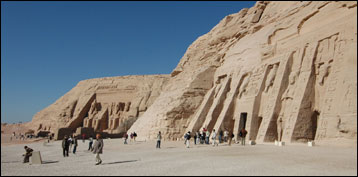



Abu Simbel
page 2

Interesting
Abu Simbel
facts and tidbits
Abu Simbel has many:
 Construction tim
Construction tim
It took several decades for the ancients to build the Abu Simbel, a wonder in southern Egypt.
 Saved by sand
Saved by sand
Most temples of antiquity are eventually physically altered, defiled or destroyed. This was not the fate of Abu Simbel because encroaching sands soon buried its lower half. It lay forgotten for millennia. Abu Simbel wasn't rediscovered and fully exposed until about 200 years ago.
 Earthquake damage
Earthquake damage
The second from the left Pharaoh statue was severely damaged by an ancient earthquake. The shattered fallen head and torso lie at the statue's feet.
 Artificial cliff
Artificial cliff
Originally, the backdrop of Abu Simbel was the cliff it was carved out of. Problem: The 1960s relocated temple would be on top of the cliff, which had no backdrop. Solution: Construct an artificial mountain behind the relocated temple's facade.
 Most sacred chamber
Most sacred chamber
Abu Simbel's innermost room lies at the end of a long corridor straight back from the temple's entrance. Once only the Pharaoh and high priests could go inside this ultra holy sanctuary. Now you can, too.
 Equinox show
Equinox show
Twice a year a shaft of light from the rising sun mystically illuminates the deity statues inside the innermost room. This occurs during the spring and fall equinoxes (late February and October).
 Rameses II
Rameses II
The man who commissioned Abu Simbel is considered the greatest Pharaoh ever. He reigned for a long time - 67 years (1279 to 1213 BC).
 Mummy
Mummy
His 3200 year old mummy is dramatically displayed (head and hand are unwrapped) in the Egyptian Museum in Cairo.
Learn More
Read about each of Egypt's top 7
 Pyramids of Egypt at Giza
Pyramids of Egypt at Giza
 Karnak Temple
Karnak Temple
 Nile River Cruise
Nile River Cruise
 Egyptian Museum
Egyptian Museum
 Valley of the Kings
Valley of the Kings
 Abu Simbel
Abu Simbel
 Luxor Temple
Luxor Temple

Francesco Gasparetti - CC BY 2.0


World's Top 100 Wonders
World's Top 1000 Wonders
Site map
My credentials
About my website and criteria
Reader testimonials




